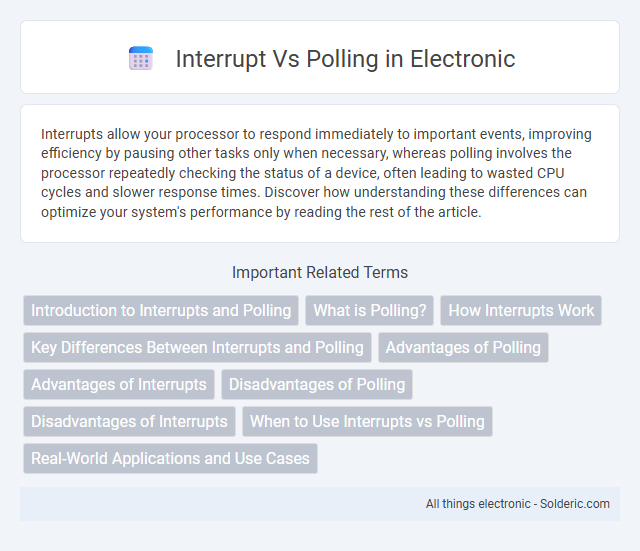Interrupts allow your processor to respond immediately to important events, improving efficiency by pausing other tasks only when necessary, whereas polling involves the processor repeatedly checking the status of a device, often leading to wasted CPU cycles and slower response times. Discover how understanding these differences can optimize your system's performance by reading the rest of the article.
Comparison Table
| Feature | Interrupt | Polling |
|---|---|---|
| Definition | Processor is alerted by hardware signals to handle events immediately. | Processor continuously checks the status of a device at regular intervals. |
| CPU Efficiency | High efficiency; CPU performs other tasks until interruption. | Lower efficiency; CPU wastes cycles checking devices unnecessarily. |
| Response Time | Fast; event-driven immediate attention. | Slower; response depends on polling interval. |
| Complexity | Higher; requires interrupt handling and vector table management. | Simple; straightforward loop-based checking. |
| Use Cases | Real-time systems, multitasking environments, devices with unpredictable I/O. | Simple or low-speed devices, systems with predictable polling frequency. |
| Power Consumption | Lower; CPU sleeps or performs other tasks until interrupt. | Higher; constant checking increases power usage. |
| Hardware Support | Requires interrupt controller and support in CPU architecture. | No special hardware needed beyond basic device status registers. |
Introduction to Interrupts and Polling
Interrupts allow a CPU to respond immediately to critical events by suspending its current tasks and executing an interrupt service routine. Polling involves the CPU repeatedly checking the status of a device or condition at regular intervals to determine if attention is needed. Both techniques manage hardware communication, with interrupts offering efficient asynchronous responses and polling providing a simpler but potentially slower synchronous approach.
What is Polling?
Polling is a technique where the CPU repeatedly checks the status of an I/O device to determine if it needs attention or data processing. It involves continuous querying of the device's status register, causing the CPU to wait in a loop, which can lead to inefficient use of processing resources. Polling is simple to implement but can result in higher latency and CPU overhead compared to interrupt-driven communication.
How Interrupts Work
Interrupts work by sending a signal to the processor, temporarily halting the current execution to address urgent tasks. The CPU saves the current state and jumps to a specific interrupt handler to process the event before resuming the interrupted program. Your system's responsiveness improves significantly as interrupts allow immediate attention to high-priority events without continuous polling.
Key Differences Between Interrupts and Polling
Interrupts allow the CPU to respond immediately to high-priority events by pausing current tasks, while polling continuously checks device status at regular intervals, consuming more CPU resources. Interrupts optimize system efficiency by triggering actions only when necessary, whereas polling can cause delays and inefficiencies due to constant querying. Understanding these key differences helps you choose the right method for timely and resource-effective hardware communication in your applications.
Advantages of Polling
Polling offers advantages such as simplicity in implementation and precise control over when the CPU checks device status, reducing the complexity of interrupt handling routines. It ensures predictable system behavior because the CPU periodically queries devices at set intervals, which can simplify timing and synchronization in real-time applications. Polling also minimizes interrupt overhead, which can be beneficial in systems with low device activity or where interrupts can cause significant latency.
Advantages of Interrupts
Interrupts offer significant advantages in computer systems by allowing the CPU to respond immediately to high-priority events, improving overall efficiency and system performance. Unlike polling, which continuously checks device status and wastes CPU cycles, interrupts free the processor to perform other tasks until an event occurs. Your system benefits from reduced latency and better resource utilization, making interrupts essential for real-time and multitasking environments.
Disadvantages of Polling
Polling consumes significant CPU resources by continuously checking device status, which reduces overall system efficiency and performance. It introduces latency since the CPU might waste cycles waiting rather than performing other tasks, causing slower response times in time-critical applications. Polling can lead to missed or delayed events if the polling interval is not adequately optimized, impacting system reliability in real-time environments.
Disadvantages of Interrupts
Interrupts can lead to increased complexity in system design, requiring careful management of context switching and interrupt handling routines. High interrupt frequency may cause excessive CPU overhead, reducing overall system performance and causing delays in executing critical tasks. Additionally, improper handling of interrupts can result in missed or lost signals, leading to data corruption or system instability.
When to Use Interrupts vs Polling
Use interrupts when your system requires immediate attention to asynchronous events, such as input from hardware devices or critical signals, to improve efficiency and responsiveness by allowing the CPU to execute other tasks until an event occurs. Polling suits scenarios with predictable or low-frequency events where waiting or constant monitoring doesn't significantly affect performance, and simplicity or timing control is more important than resource conservation. Your choice depends on balancing system complexity, power consumption, latency requirements, and overall processing overhead.
Real-World Applications and Use Cases
Interrupt-driven systems are essential in real-time applications like automotive airbag deployment and medical monitoring devices, where immediate response to sensor input is critical. Polling is commonly used in simpler, less time-sensitive systems such as keyboard input detection or periodic status checks in embedded devices. Your choice between interrupt and polling techniques depends on the required responsiveness and system resource constraints of the specific application.
Interrupt vs Polling Infographic

 solderic.com
solderic.com